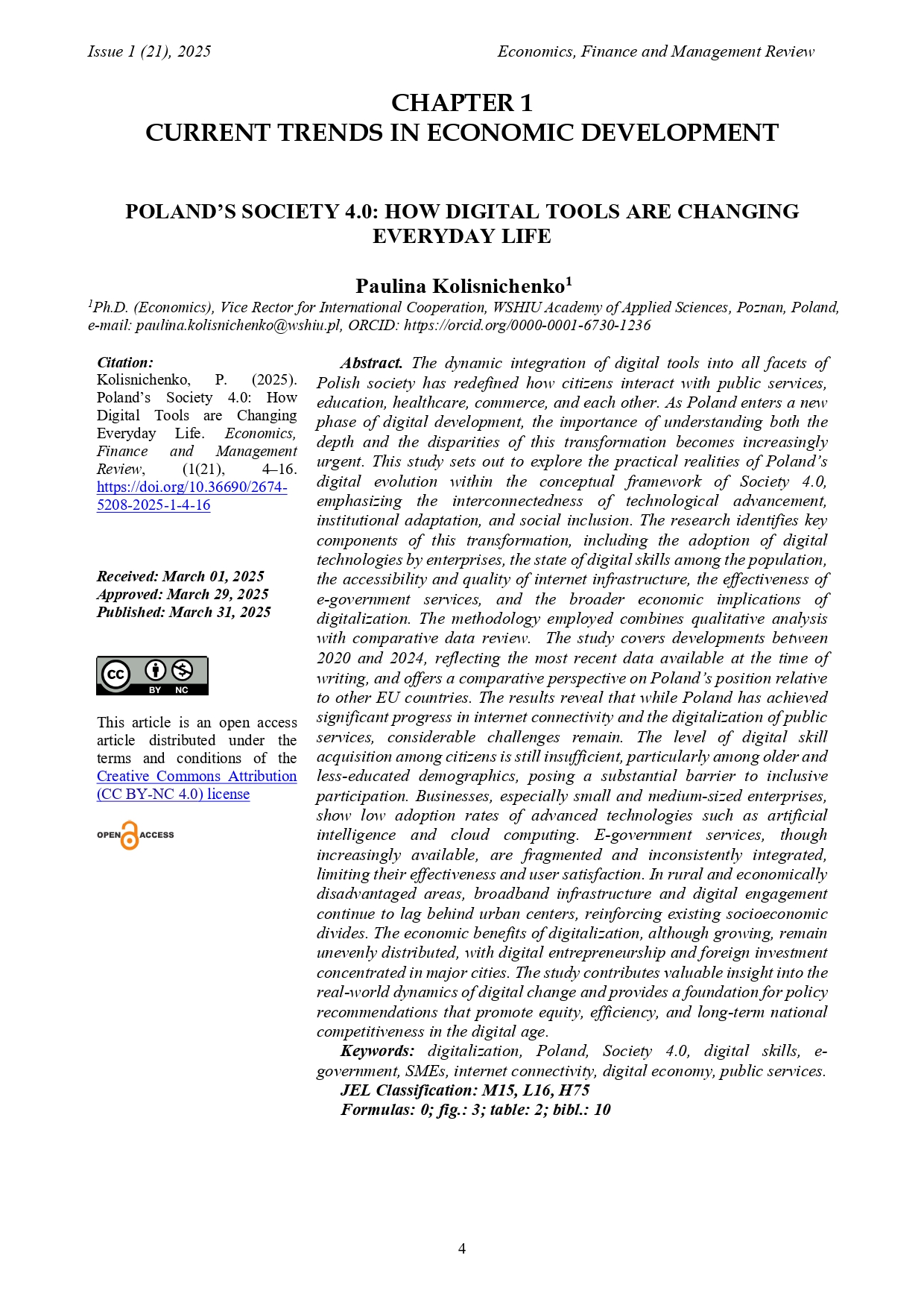POLAND’S SOCIETY 4.0: HOW DIGITAL TOOLS ARE CHANGING EVERYDAY LIFE
DOI:
https://doi.org/10.36690/2674-5208-2025-1-4-16Keywords:
digitalization, Poland, Society 4.0, digital skills, e-government, SMEs, internet connectivity, digital economy, public servicesAbstract
The dynamic integration of digital tools into all facets of Polish society has redefined how citizens interact with public services, education, healthcare, commerce, and each other. As Poland enters a new phase of digital development, the importance of understanding both the depth and the disparities of this transformation becomes increasingly urgent. This study sets out to explore the practical realities of Poland’s digital evolution within the conceptual framework of Society 4.0, emphasizing the interconnectedness of technological advancement, institutional adaptation, and social inclusion. The research identifies key components of this transformation, including the adoption of digital technologies by enterprises, the state of digital skills among the population, the accessibility and quality of internet infrastructure, the effectiveness of e-government services, and the broader economic implications of digitalization. The methodology employed combines qualitative analysis with comparative data review. The study covers developments between 2020 and 2024, reflecting the most recent data available at the time of writing, and offers a comparative perspective on Poland’s position relative to other EU countries. The results reveal that while Poland has achieved significant progress in internet connectivity and the digitalization of public services, considerable challenges remain. The level of digital skill acquisition among citizens is still insufficient, particularly among older and less-educated demographics, posing a substantial barrier to inclusive participation. Businesses, especially small and medium-sized enterprises, show low adoption rates of advanced technologies such as artificial intelligence and cloud computing. E-government services, though increasingly available, are fragmented and inconsistently integrated, limiting their effectiveness and user satisfaction. In rural and economically disadvantaged areas, broadband infrastructure and digital engagement continue to lag behind urban centers, reinforcing existing socioeconomic divides. The economic benefits of digitalization, although growing, remain unevenly distributed, with digital entrepreneurship and foreign investment concentrated in major cities. The study contributes valuable insight into the real-world dynamics of digital change and provides a foundation for policy recommendations that promote equity, efficiency, and long-term national competitiveness in the digital age.
Downloads
References
European Commission. (2021). Recovery and Resilience Facility: Country allocations and digital spending targets. Retrieved from https://ec.europa.eu/
European Commission. (2022). Digital Economy and Society Index (DESI) 2022. Retrieved from https://digital-strategy.ec.europa.eu/en/policies/desi
European Commission. (2022). Digital Decade Policy Programme 2030. Retrieved from https://digital-strategy.ec.europa.eu/en/policies/digital-decade
Eurostat. (2021). Digital economy and society statistics—households and individuals. Retrieved from https://ec.europa.eu/eurostat
Eurostat. (2023). Individuals with at least basic digital skills, by sex, 2023. Retrieved from https://ec.europa.eu/eurostat
Kolisnichenko, P. (2024). Digitalizing Economic Education in Poland: Challenges, Innovations, and Opportunities. In M.Denysenko, L. Khudoliy & S. Laptiev (Eds.), Digital Skills in a Digital Society: Requirements and Challenges. 2024. 394 p. (pp. 307–330). Scientific Center of Innovative Research. Estonia. https://doi.org/10.36690/DSDS-307-330
mObywatel. (2023). Digital identity and public services app—User data and development updates. Retrieved from https://www.gov.pl/web/cyfryzacja/mobywatel
Polish Central Statistical Office (GUS). (2024). Information society in Poland 2023. Retrieved from https://stat.gov.pl/en/
Polish Ministry of Digital Affairs. (2024). Digital Strategy 2035. Retrieved from https://www.gov.pl/web/cyfryzacja/
Digital Poland Operational Programme. (2024). Improving access to broadband internet and reducing digital exclusion. Retrieved from https://www.polskacyfrowa.gov.pl/

Downloads
Published
How to Cite
Issue
Section
License

This work is licensed under a Creative Commons Attribution-NonCommercial 4.0 International License.








